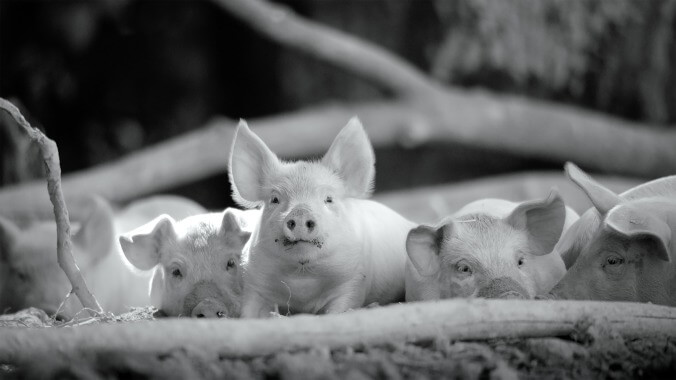Decades of anthropomorphizing nature documentaries have conditioned viewers to look for characters to root for in movies about the real lives of real animals. For a fleeting moment, Gunda appears to be indulging that very expectation. Victor Kossakovsky’s striking black-and-white portrait of a farm in Norway opens with its title critter, a pregnant sow, giving birth to a dozen piglets. As these newborns swarm the teat, an offscreen sibling misses the meal. This is the runt of the litter, and when its mother finally digs the adorable thing out of the hay it’s been buried beneath since coming into the world, it’s easy to wonder if we’re meeting the plucky underdog hero of our story. Will this be a nonfiction answer to Babe? It’s all very cute, even a little Disney… right until the moment that Gunda crushes her smallest offspring under a carelessly dropped hoof, cutting off any oohing and awing with the sudden sound of frantic squealing, maybe from baby and audience alike.
The piglet survives. Or it seems to, anyway—later on, we get a few shots of what could be the same animal, slightly older and with a leg that looks a little messed up, as though it was bent in an odd direction. But we can’t know for sure, because Gunda doesn’t identify, by name or text, any of its subjects, even Gunda herself. The pigs don’t speak aloud their thoughts in comfortingly human voices, nor is there any narration from the likes of David Attenborough or Morgan Freeman. In fact, beyond the unseen camera crew and the late, ominous arrival of a truck, humans are completely absent from the film. Kossakovsky is interested only in immersion—in offering a ground-level tour of this grubby, chaotic corner of the animal kingdom. That puts his movie in the same genus as the experimental, largely wordless nature docs produced by Harvard’s Sensory Ethnography Lab. What Sweetgrass did for sheep and Leviathan did for fish, Gunda does for Old MacDonald’s stock.
For 90 minutes, beasts go about their business, in front of a camera that’s basically an oversized microscope and to not so much as a single note of music or a sound not native to their world. Straying occasionally from the sow’s passel, Kossakovsky trails chickens that loom almost prehistorically (if nothing else, Gunda should put to rest any lingering doubt about the evolutionary link between birds and their Jurassic ancestors), and devotes a stretch to the dumbfounded stares of bovine, who pose like extras in a music video, savoring their moment in the spotlight. This will be hog heaven for a certain species of spectator—not just those who can spend an hour per exhibit at the zoo, studying the nuances of blissfully unperturbed fauna, but also anyone who prefers their documentaries light on facts/figures and heavy on splendor. It helps that the footage is gorgeous, every shot a pristinely monochromatic marvel.
Kossakovsky never humanizes his subjects. But you can see hints of personality in their primal behavior, if you squint hard enough. Or is that just projection? (Werner Herzog, one must assume, would find no kinship, no understanding, no mercy in Gunda’s eyes.) Part of the film’s tightrope act is that it gets you thinking about sentience, and maybe searching for an inner life, in animals that it stubbornly resists sentimentalizing or ascribing more advanced emotions to. Then again, maybe just filming their routines will inspire audiences to go the extra distance of identification. It’s said, after all, that humans can see themselves in anything, even the “lesser” lifeforms they consume. It’s not so hard with pigs, which are smart and social; putting their daily activity next to a chicken’s certainly makes the distinction clear.
You won’t learn much from Gunda. It’s an arty pastoral mood piece, not an educational tool. Which is not to imply it lacks a philosophy. Kossakovsky’s last documentary, Aquarela, employed jaw-dropping footage of the destructive power of water to sound an environmental alarm. Here, it’s no accident that he’s chosen to film creatures we regard almost exclusively as food. Gunda doesn’t manufacture characters, but it does, in the end, find something like an arc for its menagerie, closing as it does with an extended final shot that communicates the harsh reality of farm life in a way arguably just as upsetting—but much less expected—than a trip to the slaughterhouse. The message comes through loud and painfully clear, no dubbed voices required.










































